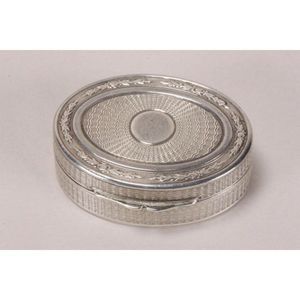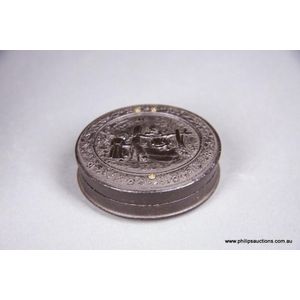Victorian Daguerrotype in Vulcanite Box
You must be a subscriber, and be logged in to view price and dealer details.
Subscribe Now to view actual auction price for this item
When you subscribe, you have the option of setting the currency in which to display prices to $Au, $US, $NZ or Stg.
- Floral Swag / Garland / Festoon - Floral swags are a decorative motif often used in the ornamentation of various objects, such as silverware, glassware, and furniture. The term "swag" refers to a garland or wreath of flowers, foliage, or other decorative elements, which is usually arranged in a loop or curve.
Floral swags can be found in a variety of decorative styles, from ornate Baroque and Rococo designs to more naturalistic Art Nouveau and Art Deco styles. They are often used to add a touch of elegance, refinement, or whimsy to an object, and can be seen on a range of items from chandeliers and candlesticks to picture frames and tea sets.
In the decoration of silver objects, floral swags are often used to accentuate the curves and lines of the piece, and to add visual interest to the surface. Similarly, on glass objects, floral swags may be used to frame or highlight a particular area of the object, or to add a touch of color and delicacy.
On furniture, floral swags can be found on a variety of pieces, from cabinets and armoires to chairs and sofas. They are often used to enhance the lines and curves of the furniture, and can be used to create a sense of movement and flow in the design.
Overall, floral swags are a versatile decorative element that can be adapted to a range of styles and applications, and have been used in the decoration of various objects throughout history. - Circa - A Latin term meaning 'about', often used in the antique trade to give an approximate date for the piece, usually considered to be five years on either side of the circa year. Thus, circa 1900 means the piece was made about 1900, probably between 1895 and 1905. The expression is sometimes abbreviated to c.1900.
- Daguerreotype - The first photographic image was achieved in 1814 by Frenchman Joseph Niepce, with first photographic with the camera obscura, an optical device that projects an image onto a screen. However, the image required eight hours of light exposure and later faded.
Joseph Niepce continued working on improving his invention Louis-Jacques-Mandé Daguerre, an artist. Niepce died in 1833, but Daguerre carried on, and at a meeting of the French Academy of Sciences in Paris on August 19, 1839 announced he had discovered a new method of photography, the daguerreotype which he named after himself. The daguerreotype process reduced the exposure time from 8 hours to 3 - 15 minutes.
In major cities, professional photographers of the time, known as daguerreotypists, invited celebrities and political figures to their studios, hoping that by displaying a selection of portraits in their windows, the public would be encouraged to be photographed.
However the popularity of the daguerreotype was short-lived, and its use declined in the late 1850s when the ambrotype, a faster and less expensive photographic process, became available. However the ambrotype still required the services of a professional photographer and it was not until the invention of Kodak's Box Brownie in 1900 that the public were able to shoot their own photographs.
Due to the short time (20 years) that the daguerreotype was popular, and the fact that the image was produced directly onto the plate, meaning there were no negatives, original daguerreotypes are scarce. Most daguerreotypes are portraits, with landscapes and street scenes being less less common. - Victorian Period - The Victorian period of furniture and decorative arts design covers the reign of Queen Victoria from 1837 to 1901. There was not one dominant style of furniture in the Victorian period. Designers used and modified many historical styles such as Gothic, Tudor, Elizabethan, English Rococo, Neoclassical and others, although use of some styles, such as English Rococo and Gothic tended to dominate the furniture manufacture of the period.
The Victorian period was preceded by the Regency and William IV periods, and followed by the Edwardian period, named for Edward VII (1841 ? 1910) who was King of the United Kingdom and the British Dominions and Emperor of India for the brief period from 1901 until his death in 1910.
This item has been included into following indexes:
Visually similar items

19th century French tortoise shell and wood snuff box and cover, of circular form, decorated with a portrait roundel of classical maiden, with beaded surround, diameter 7.7 cm

An early 19th century pressed horn circular lidded snuff box, the lid decorated in relief with a classical scene of a woman in a garden with an admirer behind a pedestal urn, entitled 'The Sensitive Plant'. The base with fine complicated floral motif and b

A Duke of Wellington commemorative souvenir, circa 1815, the brass embossed boxes contains paper discs pertaining to Wellington's historic battles. 5 cm wide

Wonderfulrench pill box and cover, of oval form, with central roundel, with engine turned surround and leaf wreath, 3.5 cm x 2.5 cm
